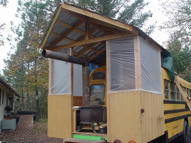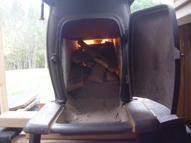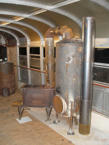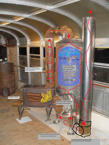Post by jgreen on Nov 7, 2009 18:56:39 GMT -8
Hey Ya'll. I'm trying to get started on a rocket stove for my housebus (I have prior rocket building experience) and am trying to put together the right combination of materials that I have already gathered for free, design that meets my heating needs and will fit in the space I have for it in the bus (allowing room for plenty of fireproof insulating materials in the appropriate places). I'm stuck in two different areas.
First, I'm trying to figure out if I can incorporate my current cast-iron stove into the design of the combustion chamber or if it makes more sense to start from scratch with firebrick and build it up like the rocket design in the original Rocket Mass heaters booklet. I've tried to embed some pictures of my current stove to help with my explanation. Should be able to click them to get them bigger. I really dig the way donkey bulk feeds the rocket in his house via the back "ash drop + cleanout". I don't fully understand why it works so well, because I always thought (from reading the dimentia + proportia section of the rocket booklet) that it was critial that the horizontal burn tunnel be the "tightest part of the intestinal system". It seems to me that donkey's cleanout-turned-feed tube has a much larger cross sectional area than the heat riser it connects to. So maybe someone who understands that could explain that part to me. But assuming you can indeed connect a long burn tunnel to a smaller (in area) heat riser, then could I use brick and/or clay/sand refractory to line the inside of my cast iron stove (pictured is a quick version with bricks) and use the entire length of the stove as the feed tube + burn chamber.

Then build the heat riser on top connecting to where the stove usually has a 6" flue pipe attached. What I have pictured is a 3' length of 6" thick walled steel pipe.

I would insulate this as in any other rocket stove. The cast-iron stove has a sliding air-intake adjuster built into the front under the door. I figured that this could serve the same function as donkey's homemade sheet metal insert. I imagine I would need to create the right shape with clay/sand mix to transition from the box shaped tunnel to the 6" round heat riser. I'm not sure what that transition would look like, but it seems important at the very least to protect the cast iron that supports the pipe from quick deterioration. I would insulate around the body of the cast-iron stove in all directions. Any opinions on if this seems like a good idea?
I do have close to enough firebrick to build a more conventional downdraft feed tube and burn tunnel, however it seems like it would take a lot more work on my part to create a good space for insulation between the bottom of the combustion chamber and my plywood subfloor in the bus. I was envisioning putting down a layer of fire-resistant cement board (hardiboard) with firebrick on top on edge spaced apart to make channels that would be filled with perlite. Then another layer of hardiboard, then a course of bricks flat and then starting with bricks on edge to form the sides of the tunnel. Whereas the cast-iron stove has 4 legs that give me an 8" gap that I can fill with loose perlite and have a lot of insulation pretty quickly and easily.
My other big question mark deals with how I will utilize the heat stream after it leaves the combustion unit. I have a salvaged 17-ish Gallon electric water heater that I would like to heat and after much consideration, it seems the simplest and most straight-forward to just incorporate the tank into the flue so that hot gasses move over and around it. It seems best to put this as close to the hottest exhaust straight out of the heat-riser as possible. If I had more vertical clearance I might try to put it right over the heat riser, but as is I'll need to have it sitting to the side. So I'll need to reverse the direction of the rising exhaust and the easy way I know how to do that is to use a big upside-down barrel. But then I have a much bigger radiator than I need or want at that point in the flow! Is it effective to surround the barrel with insulation in order to keep the temperature nice and high or should I be thinking up a heavy duty 180 degree elbow that can attach to the top of my 6" steel heat riser?
I'm also wondering what the likely hood is of creating a dangerous pressure/steam build up in that water heater tank over the course of a longer burn. I dont really have a sense of how quickly a stove in this configuration can heat up 17 gallons of water. However my bus does not have a pressurized water supply and I'm not sure I'm going in that direction, so I'll need a way to fill the tank by hand anyways. I was thinking I would cut the top off of another old water heater I have and flip it upside down to make a big, open metal pot. One of the pipes coming out of the bottom would connect into the cold of my 17 gal. tank. Another pipe, located higher up inside this open pot would Tee into the hot connection of the 17 gal tank (the other part of the Tee would be my spigot for using the water). This would create a way to fill the tank (via manually filling the open topped pot) and also a backup pressure release in the form of a thermosiphon. Any reason this wouldn't thermosiphon if typical guidelines were followed (big enough piping, big enough vertical distance between tanks)?
One last thing. Does anyone know about what temperature galvanized sheet steel starts to release toxic gases? I have a bunch of pretty heavy gal. sheet that I would love to use up and incorporate into the stove, but of course my priority is to have a safe stove. My thinking was along the lines of using it to make barriers to hold loose perlite in place around the stove innards. I'm sure the wisdom of using this involves a lot of "it depends..."
Sorry for the lengthy post. This is a weeks worth of thinking about this to myself all coming out at the same time, in the same place. And I only have internet access on a couple days of the week. I would apprecate any and all feedback. Anything that comes to mind. Much thanks.
-Jay.
First, I'm trying to figure out if I can incorporate my current cast-iron stove into the design of the combustion chamber or if it makes more sense to start from scratch with firebrick and build it up like the rocket design in the original Rocket Mass heaters booklet. I've tried to embed some pictures of my current stove to help with my explanation. Should be able to click them to get them bigger. I really dig the way donkey bulk feeds the rocket in his house via the back "ash drop + cleanout". I don't fully understand why it works so well, because I always thought (from reading the dimentia + proportia section of the rocket booklet) that it was critial that the horizontal burn tunnel be the "tightest part of the intestinal system". It seems to me that donkey's cleanout-turned-feed tube has a much larger cross sectional area than the heat riser it connects to. So maybe someone who understands that could explain that part to me. But assuming you can indeed connect a long burn tunnel to a smaller (in area) heat riser, then could I use brick and/or clay/sand refractory to line the inside of my cast iron stove (pictured is a quick version with bricks) and use the entire length of the stove as the feed tube + burn chamber.

Then build the heat riser on top connecting to where the stove usually has a 6" flue pipe attached. What I have pictured is a 3' length of 6" thick walled steel pipe.

I would insulate this as in any other rocket stove. The cast-iron stove has a sliding air-intake adjuster built into the front under the door. I figured that this could serve the same function as donkey's homemade sheet metal insert. I imagine I would need to create the right shape with clay/sand mix to transition from the box shaped tunnel to the 6" round heat riser. I'm not sure what that transition would look like, but it seems important at the very least to protect the cast iron that supports the pipe from quick deterioration. I would insulate around the body of the cast-iron stove in all directions. Any opinions on if this seems like a good idea?
I do have close to enough firebrick to build a more conventional downdraft feed tube and burn tunnel, however it seems like it would take a lot more work on my part to create a good space for insulation between the bottom of the combustion chamber and my plywood subfloor in the bus. I was envisioning putting down a layer of fire-resistant cement board (hardiboard) with firebrick on top on edge spaced apart to make channels that would be filled with perlite. Then another layer of hardiboard, then a course of bricks flat and then starting with bricks on edge to form the sides of the tunnel. Whereas the cast-iron stove has 4 legs that give me an 8" gap that I can fill with loose perlite and have a lot of insulation pretty quickly and easily.
My other big question mark deals with how I will utilize the heat stream after it leaves the combustion unit. I have a salvaged 17-ish Gallon electric water heater that I would like to heat and after much consideration, it seems the simplest and most straight-forward to just incorporate the tank into the flue so that hot gasses move over and around it. It seems best to put this as close to the hottest exhaust straight out of the heat-riser as possible. If I had more vertical clearance I might try to put it right over the heat riser, but as is I'll need to have it sitting to the side. So I'll need to reverse the direction of the rising exhaust and the easy way I know how to do that is to use a big upside-down barrel. But then I have a much bigger radiator than I need or want at that point in the flow! Is it effective to surround the barrel with insulation in order to keep the temperature nice and high or should I be thinking up a heavy duty 180 degree elbow that can attach to the top of my 6" steel heat riser?
I'm also wondering what the likely hood is of creating a dangerous pressure/steam build up in that water heater tank over the course of a longer burn. I dont really have a sense of how quickly a stove in this configuration can heat up 17 gallons of water. However my bus does not have a pressurized water supply and I'm not sure I'm going in that direction, so I'll need a way to fill the tank by hand anyways. I was thinking I would cut the top off of another old water heater I have and flip it upside down to make a big, open metal pot. One of the pipes coming out of the bottom would connect into the cold of my 17 gal. tank. Another pipe, located higher up inside this open pot would Tee into the hot connection of the 17 gal tank (the other part of the Tee would be my spigot for using the water). This would create a way to fill the tank (via manually filling the open topped pot) and also a backup pressure release in the form of a thermosiphon. Any reason this wouldn't thermosiphon if typical guidelines were followed (big enough piping, big enough vertical distance between tanks)?
One last thing. Does anyone know about what temperature galvanized sheet steel starts to release toxic gases? I have a bunch of pretty heavy gal. sheet that I would love to use up and incorporate into the stove, but of course my priority is to have a safe stove. My thinking was along the lines of using it to make barriers to hold loose perlite in place around the stove innards. I'm sure the wisdom of using this involves a lot of "it depends..."
Sorry for the lengthy post. This is a weeks worth of thinking about this to myself all coming out at the same time, in the same place. And I only have internet access on a couple days of the week. I would apprecate any and all feedback. Anything that comes to mind. Much thanks.
-Jay.








